By David O. Russell
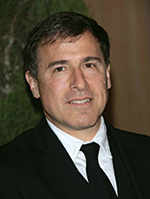 Silver Linings Playbook (2012), about
two damaged people who come together against all
odds, has David O. Russell firing on all cylinders. It
would end up earning eight Academy Award nominations,
including best picture and director, as well
as nominations in the four acting categories. It was also Russell's
first outing with Jennifer Lawrence—who triumphed on Oscar
night; the collaboration would continue to blossom in two subsequent
movies.
Silver Linings Playbook (2012), about
two damaged people who come together against all
odds, has David O. Russell firing on all cylinders. It
would end up earning eight Academy Award nominations,
including best picture and director, as well
as nominations in the four acting categories. It was also Russell's
first outing with Jennifer Lawrence—who triumphed on Oscar
night; the collaboration would continue to blossom in two subsequent
movies.
As Russell explains, the dance competition sequence forms "the
emotional and narrative culmination of the entire film," when all
the hopes and dreams of not just Pat (Bradley Cooper) and Tiffany
(Lawrence) are at stake, but those of Pat's parents, particularly
Pat Sr. (Robert De Niro), a bookmaker whose future is riding on
the outcome of both the dance and a football game between his
beloved Eagles and the Cowboys.
The sequence is packed with intricate detail, not just technically
(Russell's work with DP Masa Takayanagi is filled with dynamic
movement and framing, and punctuated by countless light sources)
but also psychologically, with mere glances that tell a thousand
words, and ulterior motives that get played out in the most exhilarating
fashion.
Here then, in his own words. -Steve Chagollan
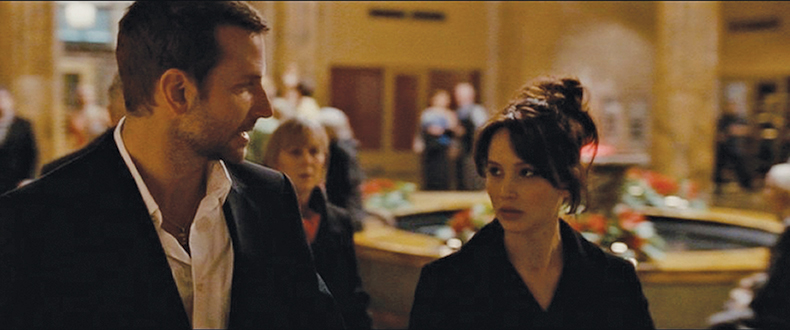
This is the quiet before the storm. It
was essential to set the stage for the
third act like a curtain opening, because
so many different emotional hopes and
bets and people were all involved in the dance,
whether watching or participating: parents,
friends, estranged wife—all in an unknown public
competitive arena filled with professional
dancers. Moving into these beckoning chambers
achieved the feeling of going deeper into a new
and momentous event and also allowed us to
locate all the many characters emotionally invested
throughout the space.
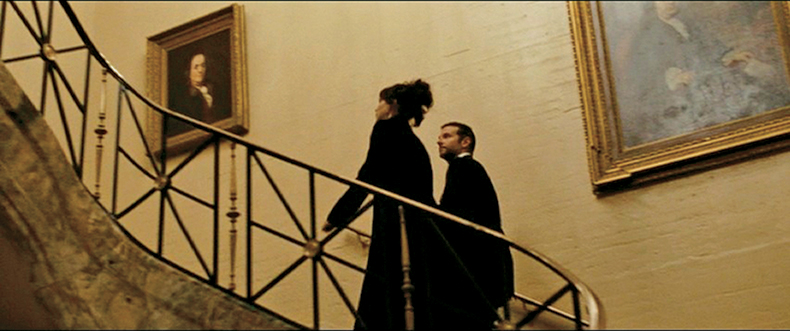
The actual location of the Benjamin
Franklin Hotel in Philadelphia has
the authentic feel of a historical local
landmark that holds benefit events like this
one—a kind of a middle-to working-class event.
The hotel itself is a Chinese box of successive
spaces, entrances, marble stairs, a downstairs
bar, an upper tier to look down through a railing,
an upstairs lobby and corridor, as well as a huge,
two-tiered, 60-foot-ceiling ballroom.

The ballroom has an emotional buildup
for Pat and Tiffany, and everyone
else. We feel all points of view, leading
with Pat's and Tiffany's; as he is serene, taking
in the entire room because he has a secret plan;
and she is coming undone, because her hidden
plan seems to have fallen apart as she storms
across the loud ballroom and hides, almost quits
really, by sitting at a small bar and allowing a
stranger to buy her multiple vodkas.
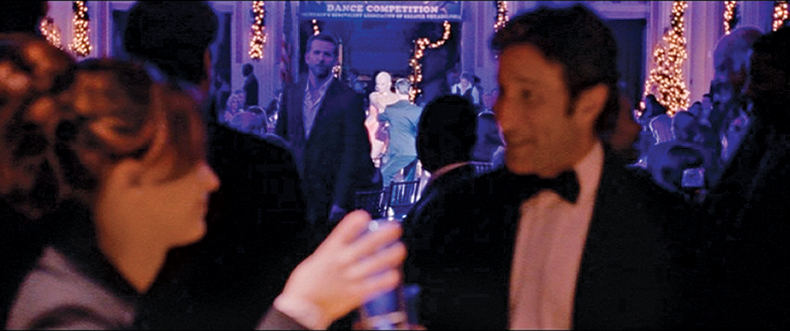
The lighting in the film in general, with
DP Masa Takayanagi and gaffer Bill
O'Leary, aspired to be as soft and natural
as possible, from windows and soft practical
sources that allow actors to move freely in and
out of shadows and light. In contrast, the hotel
lobby was bright downstairs, filled with sparkling
holiday lights, then dim again upstairs,
then dark with pools of light and an overall
sense of scale, crowd, and a kind of magic lighting
around the perimeter, with the dance floor
bright at its center.
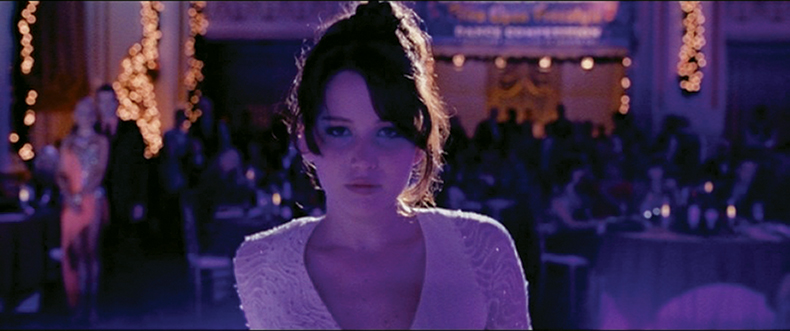
Unlike the bright dance floor of the
orthodox professional dancers, the
floor went dark for Pat and Tiffany and
would rely on high follow spots posted at either
end of the ballroom. In addition to accentuating
the vast depth of the space, this allowed the
actors to be backlit with a flare into the lens,
which has a messy aliveness and immediacy.
It also allowed the dancers to move in and out
of circles of direct follow spotlight in the dark.
In addition, Pat and Tiffany's lighting for the
dance was distinguished by a skirt around the
perimeter of the dance floor, designed by Masa
about six inches high all the way around, which
had been programmed in accordance with the
dance to go dark or bright or colored at different
moments.

The dance itself was designed from an
emotional standpoint when writing the
screenplay, such that it would show
three very different kinds of dance and music
and moods, using the varied colors of these
unconventional characters who had "failed"
in the normal world thus far. The songs were
grounded in who each character was. We were
privy to their unofficial courtship during dance
rehearsals at her studio so the challenge was
to still have the final dance at the competition
be a surprise to everyone, family and audience.
The first piece was Stevie Wonder ("Don't You
Worry 'Bout a Thing"), which is related to the
wedding song ("My Cherie Amour") that has
haunted Pat in his mental illness. Playing it here
was a show of mastery for him, emotionally and
mentally, to be free from his trauma. As Tiffany
had said earlier, "It's just a song, don't make it a
monster."
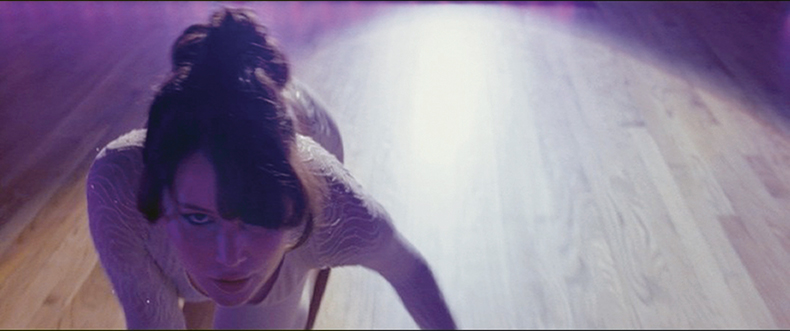
The shot list for the dance sequence
was boarded over the course of two
days beginning with wider shots of
the dance from the point of view of the family
all over the ballroom. We worked our way
into tighter, still fairly basic coverage, with
Steadicam operator Dave Thompson and AD
Shelley Ziegler, until we got onto the dance
floor and then went into the shots that were designed
to alternately follow the dancers, then let
them go wide. Dave had gone to dance rehearsals
and we knew which parts of the dance to
try different shots on (wrapping around, letting
them go, or staying with them, on which sides).
Amazing Dave eventually was dancing with
them, wearing his 70-pound Steadicam rig.

Their dancing has a homemade feeling,
very different from the professional
dancers. Pat and Tiffany were amateurs
and knew it. Over weeks of rehearsal in
pre-production, dance choreographer Mandy
Moore collaborated to emphasize this amateur
feeling while also being personal to the
characters. This dancing includes crawling and
intimacy on the dance floor (see previous image)
before exploding into the second piece of
music by the White Stripes, which adds a very
kinetic whip to a different, free, goth emotion
Tiffany carries. Lights flash very bright here,
and this sequence includes the move Danny
(Chris Tucker) suggested, which I discovered in
the 1941 film Hellzapoppin'. Pat and Tiffany are
unorthodox and wild, as they are regular, if they
are anything.

Having startled their families and
friends and strangers in attendance
with this, they just as suddenly now
stand and turn, elegantly, seamlessly, into a
more balletic dance, naturally done by the dancers
and Mandy, and Dave, and the lighting, into
a quiet stillness that leads into a formal waltz
to Dave Brubeck's cover of "Maria" from West
Side Story, which Pat's best friend, Ronnie (John
Ortiz), had talked about earlier in the film.

The goal first and foremost was to be
as intimate, emotional and personal
with the characters as possible, in addition
to seeing the dance from farther distances
and points of view, hence the varying coverages.
The many points of view were woven amid
a sense of movement, this braid and weave
of emotions—of the father, the mother (Jacki
Weaver), the best friend, the estranged wife—all
remain inside the intimate emotional pocket of
these two dancers. This was the feat expertly
braided by editor Jay Cassidy and all of our collaborators,
including Bradley Cooper and the
producers, that worked on this sequence.
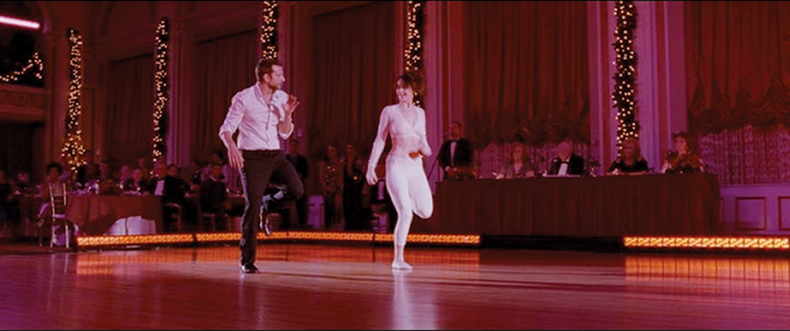
The dance turns to its penultimate
moment when they do the number
taken from Singin' in the Rain—which
Tiffany had shown Pat on her iPod in the studio,
with Gene Kelly and Donald O'Connor jumping
off the desk. The characters made their own
version of this with windmill arms and dancing
in unison. We then suddenly find ourselves arriving
at the previously established dramatic
moment of the "big move" that Tiffany insisted
they do, but which they never successfully practiced.
It feels like the culmination of the entire
film with a suspense that it could all break apart
like some ill-fated airplane in the sky.

With the dance over, we return to the
emotional predicament that interlocked
Tiffany always and most especially earlier
in the evening: Pat's estranged wife Nikki is
there, and his heart and attention and his point of
view are locked upon her. The points of view here
change multiple times—from Pat and Tiffany
embracing, to the entire family celebrating, Pat
seeing Nikki over Tiffany's shoulder, walking
toward his estranged wife, and Pat's father as
he watches all of this in alarm. The camera then
stays on Tiffany as she walks away, leaving the
shadows and pools of light of the ballroom to the
luminous, soft practical lights of the stairwell.
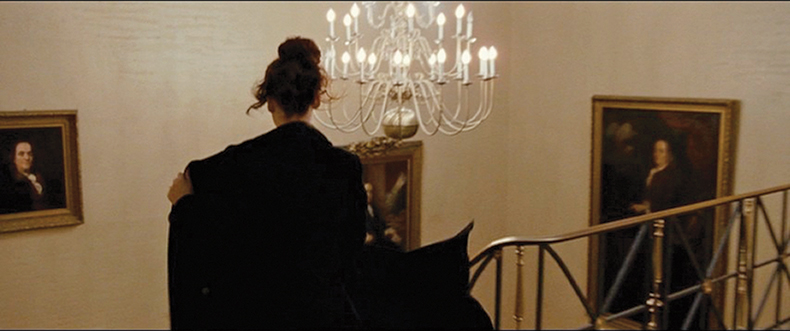
Now, coat flowing behind her like a
cape of retreat, Tiffany descends the
same winding marble staircase in
defeat that she had previously climbed with
promise and hope with Pat. She runs across
the marble lobby, seen from above through the
balcony railing in the exact same isolating bird's
eye master from which she first spied Pat's wife
at the beginning of the evening—only now as
Nikki was coming in, Tiffany is running out. She
leaves the Benjamin Franklin Hotel barefoot,
pulling on a discarded shoe like Cinderella. She's
outside, alone in the cold, escaping into her
emotional solitude, keeping her sadness private.
She feels small and isolated. These shots tended
to stay wider so you could feel that coldness
and aloneness.

Pat runs down the empty city streets
behind Tiffany—the inverse of all the
running earlier in the movie. He presents
her with his last letter and insists she read
it against her wishes. She sees it is addressed to
her and he declares his love. She asks, "You love
me?" He answers quietly, "Yeah I do." She stares.
"Okay." And she kisses him. The camera circles
them and goes to the letter clutched in her
hand, the currency of their entire secret contract
that has lead them to the dance and their union.
The camera then zips straight back a hundred
yards down the empty street of holiday lights.
The exhilaration of the pullout remains intimate
as it leaves them in context of the larger frame
and world, together.